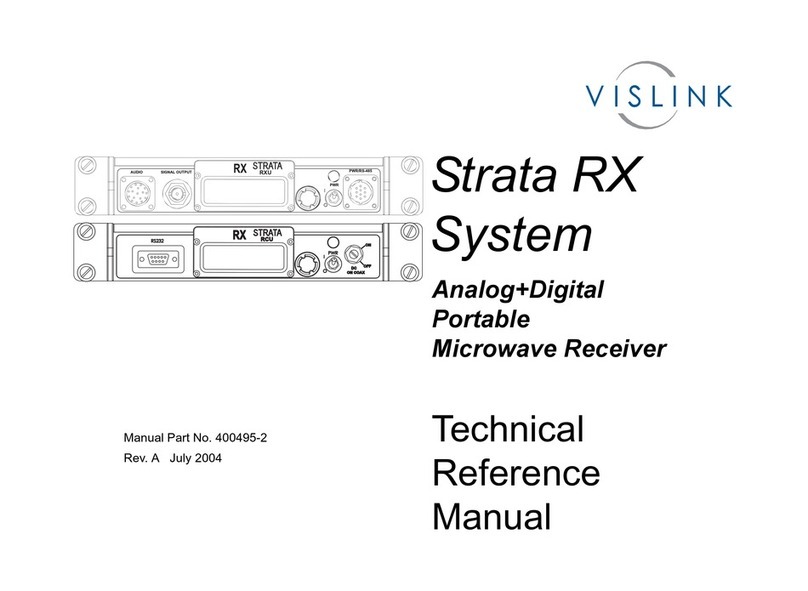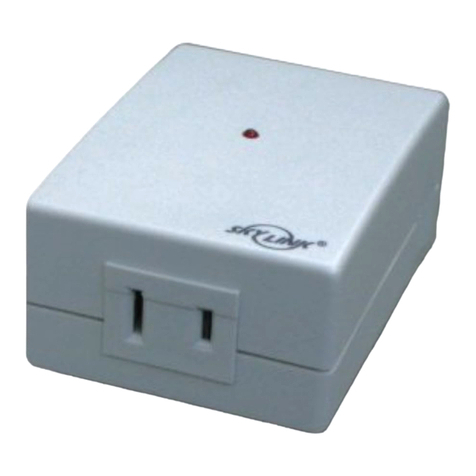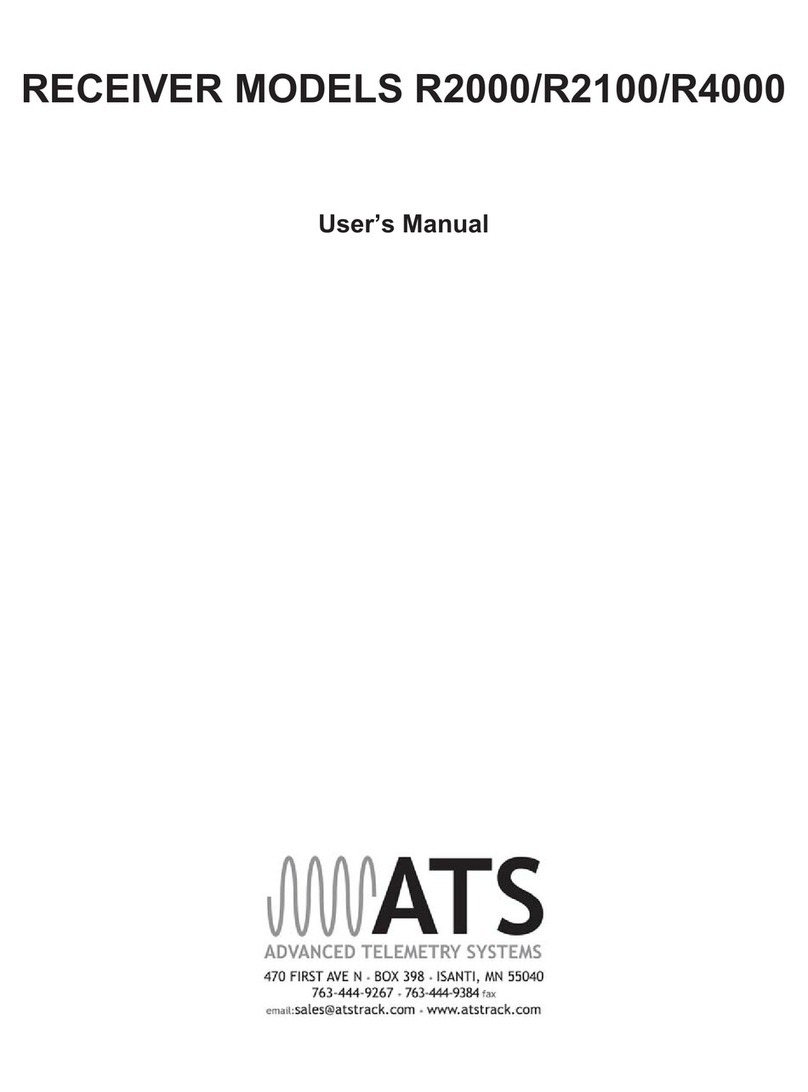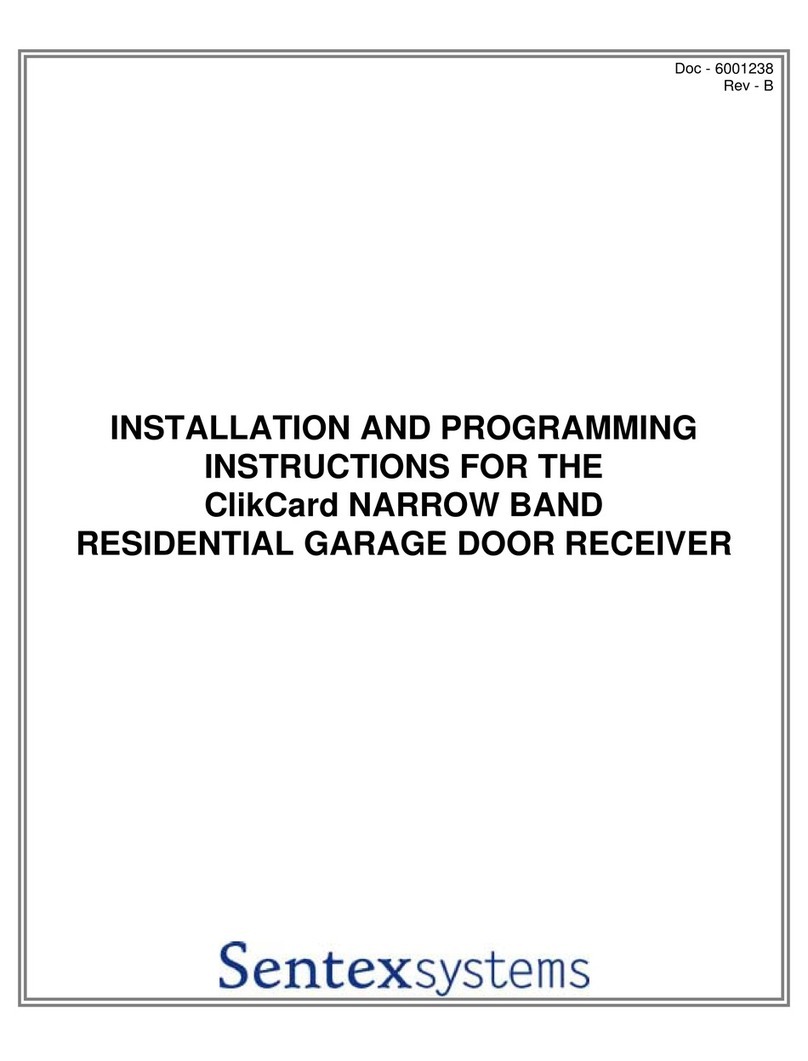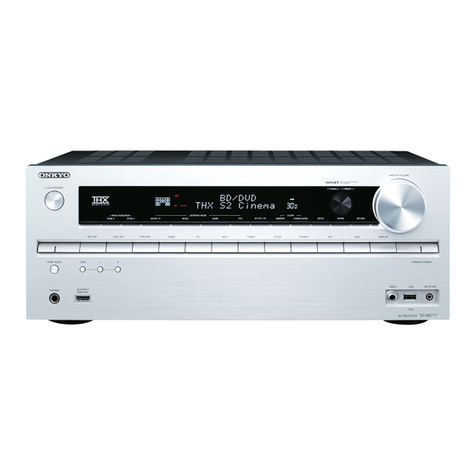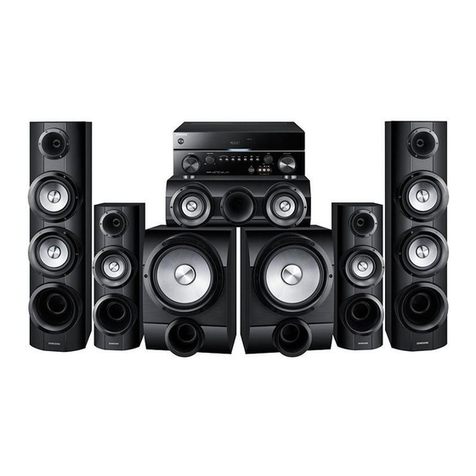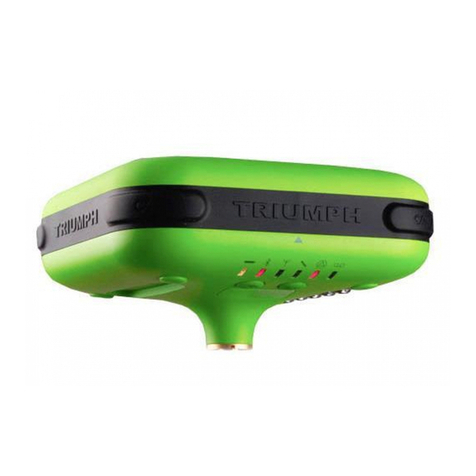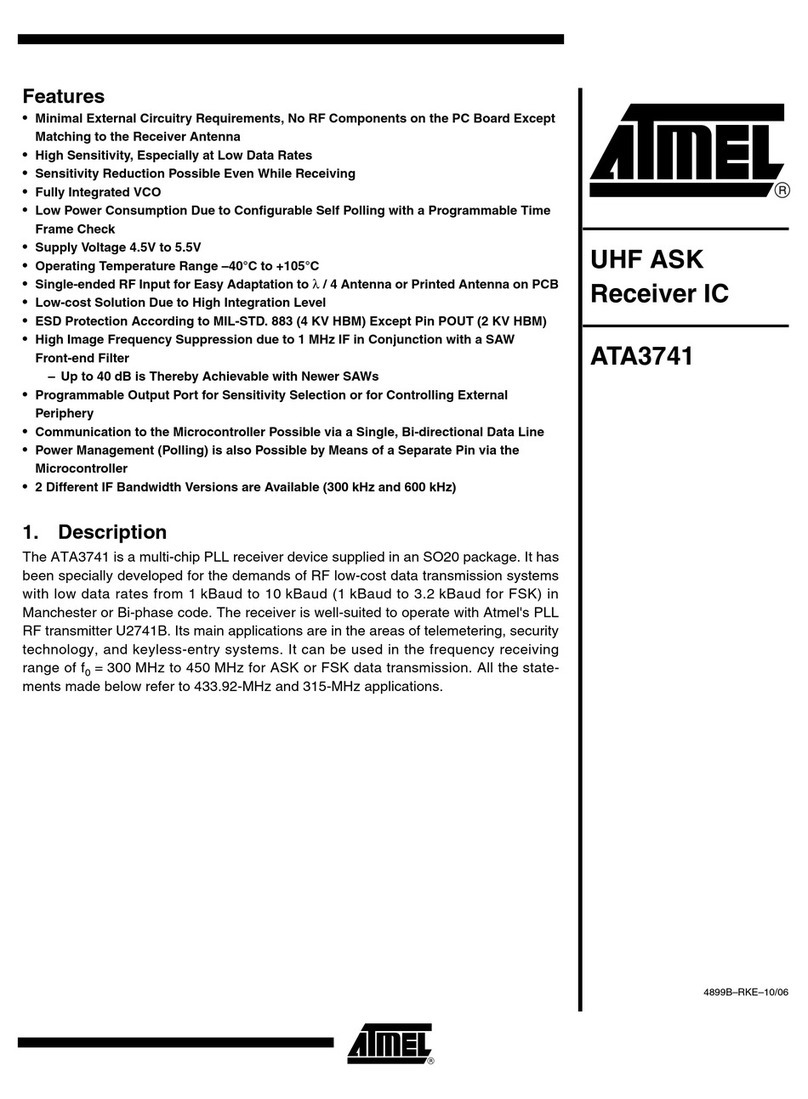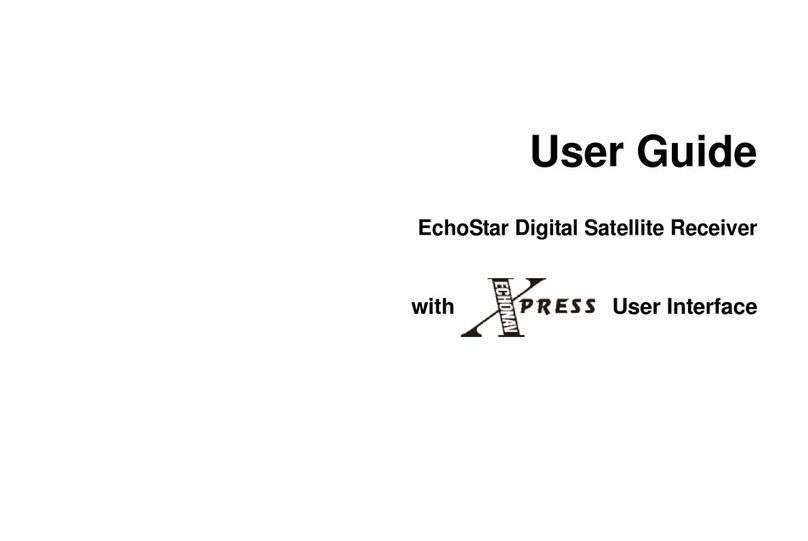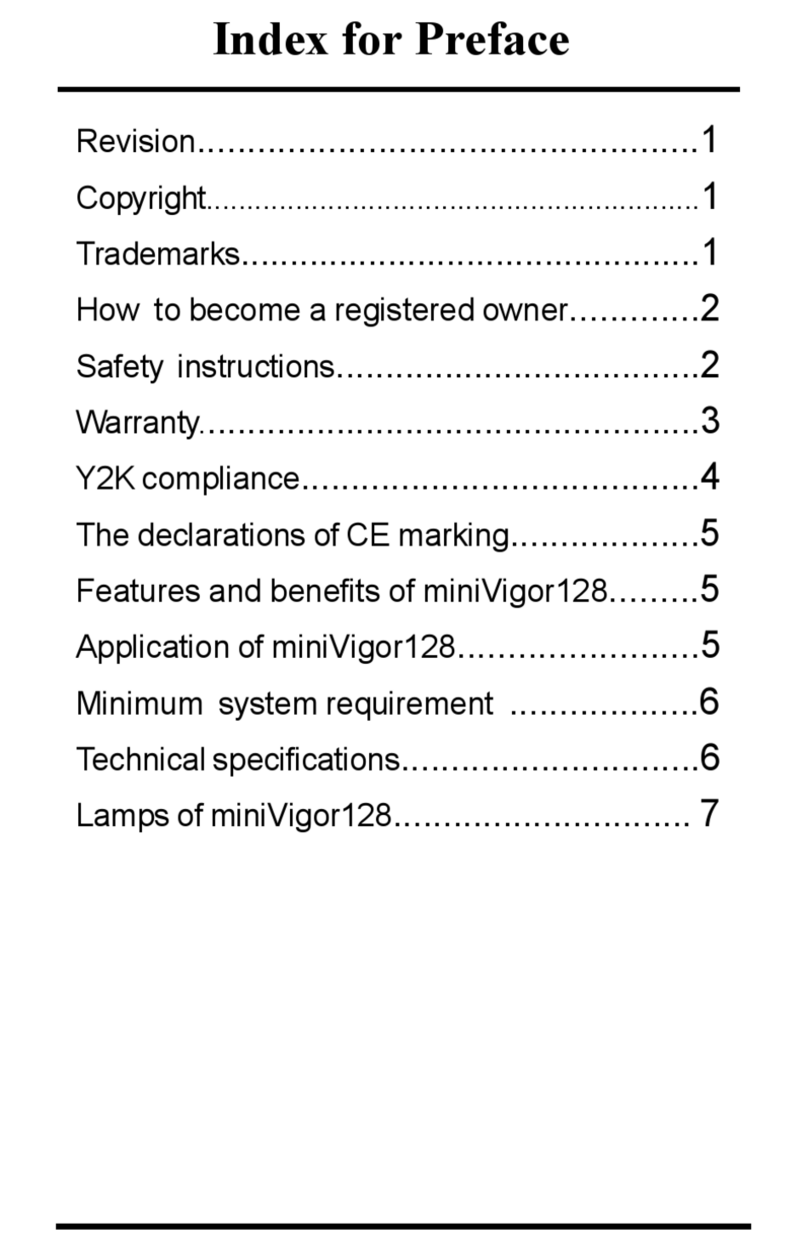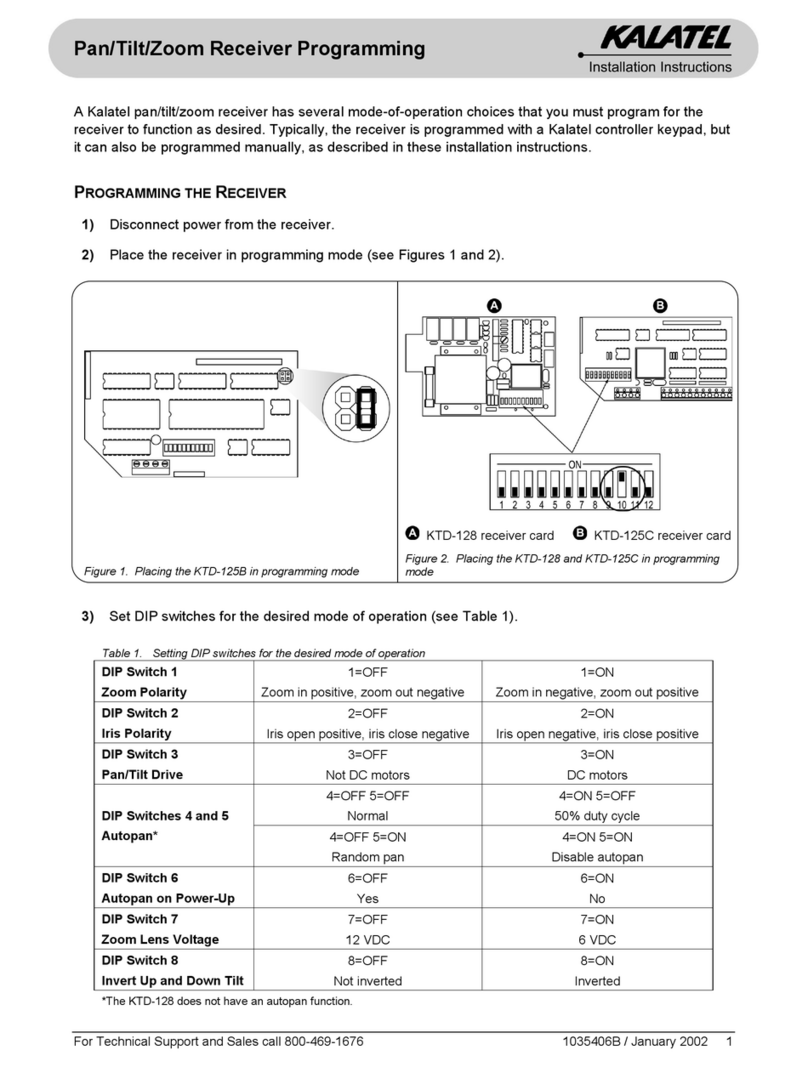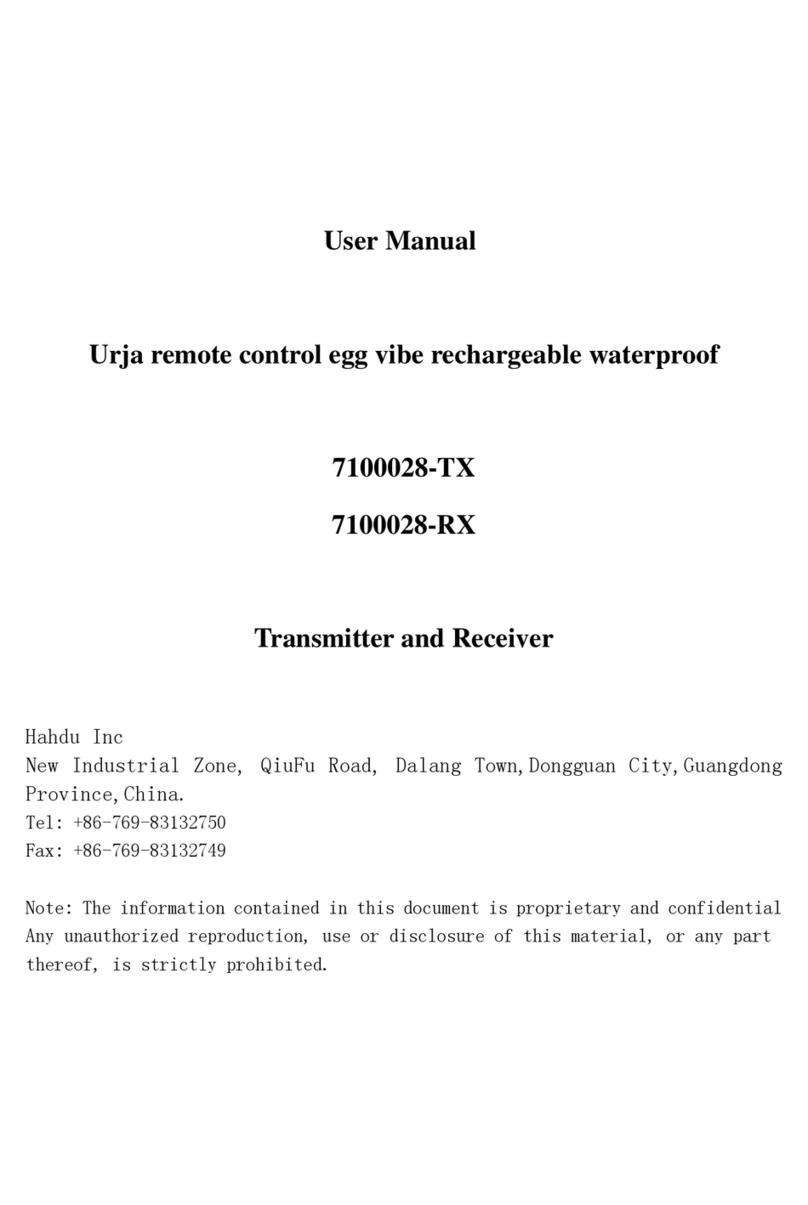Vislink UltraReceiver User manual

Vislink, Waterside House, Earls Colne Business Park, Colchester, Essex, CO6 2NS, UK
Telephone: +44 (0)1442 431300 ● Facsimile: +44 (0) 1494 775356 ● Email: sales@vislink.com ● Website: www.vislink.com
Company Registered in England & Wales no. 10523708 ● VAT registration no. GB 260 012 169
Registered Office: Waterside House, Earls Colne Business Park, Colchester, Essex, CO6 2NS, UK

Issue No: 3 Page: ii
Ref: ULRX-ASUM-700X Copyright © 2018 Vislink plc
The information contained in this manual remains the property of Vislink and may not be
used, disclosed or reproduced in any other form whatsoever without the prior written
permission of Vislink.
Vislink reserves the right to alter the equipment and specification appertaining to the
equipment described in this manual without notification.
This document is supplied on the express terms that it is to be treated as confidential and
that it may not be copied, used or disclosed to others for any purpose except as authorized
by Vislink.
NOTE: Notes are used to convey additional information.
CAUTION: Cautions highlight potential equipment damage.
WARNING: Warnings highlight potential personal danger or death. Ensure you read and
understand all warnings before attempting to carry out any work on any
equipment attached or related to the equipment in use. The danger is real and
not understanding the warning could lead to injury, harm or potential death.
Region
Contact Details
Worldwide
+44 (0) 1442 431410
+44 (0) 1787 226227
Americas
+1 978 671 5929
888 777 9221
When contacting Technical Support, please include the following information:
Model number and serial number of the unit (located on a label on the bottom of
each unit).
………………………………………….
Approximate date of purchase.
………………………………………….

Issue No: 3 Page: iii
Ref: ULRX-ASUM-700X Copyright © 2018 Vislink plc
Version
Date
Modification
FW Ver.
1
7/2/2018
First Issue
V5002 full unit
V6000 decoder
only variant.
2
29/3/18
Updates:
Section 3.1 adding DVB-T as a future option
Section 3.5 to remove packet diversity and future option from Framelock
input
Section 3.11 removing future options ASI/IP input and MPEG2 license bullets
Section 3.12.1 Inputs and outputs for future options and UHD/HD Video
outputs
3.12.1 remove incorrect ASI IN content
3.13.3 remove future option from title
Added Section 5.2.5 Genlock
Section 6.4.2.2 now 6.4.2.1 and updated last sentence (now Section
5.4.2.2 and Section 5.4.2.1 respectively)
Removed:
Section 3.13.11 –Ethernet –Video over IP
Section 5 menu overview
Section 6.1.4, Section 6.2.4.1 Descrambling,
Section 7.2.1 DVB-T
Section 7.5 through Section 7.8.
General updates to remove future options to new functionality
V6006 full unit
V6006 decoder
only variant.
3
06/11/18
Updated Demodulation Options bandwidth to 24 MHz.
Updated Note in Section 3.13 for Dual Pedestal.
Updated note in Section 5.2.5 Genlock for Lock status
Updated access receiver settings via webpage in Section 5.7
Removed old Section 6.1 Self-Test
Updated Section 6.3 Down-Converter Type removed table and replaced with
updated content.
Removed Firmware update procedure from Section 7.2. Now refer users to
the firmware release notes on the FTP site.
V10t4 Unit
V1.4.1 Decoder

Issue No: 3 Page: iv
Ref: ULRX-ASUM-700X Copyright © 2018 Vislink plc
1. Safety and Compliance .............................................................................................. 1
1.1. General Safety Information........................................................................................................1
1.2. Disposal Instructions..................................................................................................................2
1.3. Environmental............................................................................................................................2
1.4. Health & Safety ..........................................................................................................................3
1.5. Maximum RF Power Density Limits ...........................................................................................4
2. Introduction .............................................................................................................. 5
2.1. Decoder Only Variants ...............................................................................................................5
2.2. Firmware Version.......................................................................................................................5
2.3. Internal Architecture..................................................................................................................5
3. Specification.............................................................................................................. 7
3.1. Demodulation ............................................................................................................................7
3.2. Decoder Options ........................................................................................................................7
3.3. Video Formats............................................................................................................................7
3.4. Video Profiles .............................................................................................................................7
3.5. Inputs .........................................................................................................................................8
3.6. Outputs ......................................................................................................................................8
3.7. Video Outputs ............................................................................................................................8
3.8. Video Formats............................................................................................................................8
3.9. Audio Formats Supported..........................................................................................................8
3.10. Physical.......................................................................................................................................8
3.10.1. Size:............................................................................................................................................8
3.10.2. Weight:.......................................................................................................................................8
3.10.3. Power:........................................................................................................................................8
3.10.4. Environmental:...........................................................................................................................9
3.11. Optional Items............................................................................................................................9
3.12. Input / Output Connections .......................................................................................................9
3.12.1. Inputs and Outputs ....................................................................................................................9
3.13. Pinout Information...................................................................................................................10
3.13.1. RF1-4 Inputs.............................................................................................................................10
3.13.2. ASI IN........................................................................................................................................10
3.13.3. Frame lock Input ......................................................................................................................10
3.13.4. Video Outputs..........................................................................................................................10
3.13.5. ASI Output................................................................................................................................10
3.13.6. CTRL / Data...............................................................................................................................11
3.13.7. Audio 1.....................................................................................................................................11
3.13.9. Audio 2.....................................................................................................................................12
3.13.10. Camera Control/Alarm.........................................................................................................12
3.13.11. Ethernet –Control ...............................................................................................................12
4. Controls................................................................................................................... 13
4.1. Selection Keys ..........................................................................................................................13
4.2. Menu Scroll Keys......................................................................................................................13
4.3. Hot Keys ...................................................................................................................................14
4.4. LEDs..........................................................................................................................................14
4.5. USB Port ...................................................................................................................................14

Issue No: 3 Page: v
Ref: ULRX-ASUM-700X Copyright © 2018 Vislink plc
5. Main Display............................................................................................................ 15
5.1. Demodulator Menus................................................................................................................15
5.1.1. Input Mode ..............................................................................................................................15
5.1.2. Demodulator Setup..................................................................................................................15
5.1.3. Downconverters.......................................................................................................................15
5.2. Decoder Menus........................................................................................................................16
5.2.1. Inputs .......................................................................................................................................16
5.2.2. Services ....................................................................................................................................16
5.2.3. Audio Format ...........................................................................................................................16
5.2.4. Video Format (Setup)...............................................................................................................16
5.2.5. Genlock ....................................................................................................................................16
5.3. Unit Setup Menu......................................................................................................................17
5.3.1. Presets......................................................................................................................................17
5.3.2. Control Interface......................................................................................................................17
5.3.3. Defaults....................................................................................................................................17
5.3.4. Licenses....................................................................................................................................17
5.3.5. Time .........................................................................................................................................17
5.5. Support Menu ..........................................................................................................................18
5.5.1. Diagnostics...............................................................................................................................18
5.6. Camera Control ........................................................................................................................18
5.7. Menu Overview........................................................................................................................18
5.8. UltraReceiver Webserver Operation over RJ45 Port ...............................................................26
5.8.1. Setting up a Basic Connection..................................................................................................26
5.8.2. Accessing the UltraReceiver via Web Browser ........................................................................26
5.8.1. Routing Page ............................................................................................................................27
6. Receiver Setup......................................................................................................... 29
6.1. Demodulation Options.............................................................................................................29
6.1.1. DVB-T Operation......................................................................................................................30
6.1.2. LMS-T Operation......................................................................................................................31
6.2. Down-Converter Type..............................................................................................................31
6.3. Decoder....................................................................................................................................31
6.4. Deinterleaving..........................................................................................................................32
6.5. Video Over IP (Future Option) .................................................................................................32
6.5.1. Send Video Directly Over IP (Future Option)...........................................................................33
6.6. Decryption................................................................................................................................33
6.7. Independent and Customized Down Convertor Operation.....................................................33
7. Licenses and Upgrades............................................................................................. 35
7.1. Licensing...................................................................................................................................35
7.2. Firmware Upgrades..................................................................................................................35

Issue No: 3 Page: vi
Ref: ULRX-ASUM-700X Copyright © 2018 Vislink plc
Figure 2-1 Internal Architecture Overview..................................................................................... 5
Figure 3-1 Input / Output Connections .......................................................................................... 9
Figure 4-1 UltraReceiver Front Panel ........................................................................................... 13
Figure 4-2 MER (Modulation Error Ratio) Display........................................................................ 14
Figure 5-1 Web Page Example...................................................................................................... 27
Table 3-1 CTRL/Data Pinout Information.................................................................................... 11
Table 3-2 Audio 1 Pin Out ........................................................................................................... 11
Table 3-3 Audio 2 Pin Out ........................................................................................................... 12
Table 3-4 Camera Control/Alarm Pin Out ................................................................................... 12
Table 5-1 Presets Menu Overview .............................................................................................. 17
Table 5-2 Control Interface Menu Overview .............................................................................. 17
Table 5-3 Defaults Menu Overview............................................................................................. 17
Table 5-4 Diagnostics Menu Overview........................................................................................ 18
Table 6-1 DVB-T Operation Menu Overview............................................................................... 30
Table 6-2 DVB-T Bitrate Operation ............................................................................................. 30
Table 6-3 LMS-T-T Operation Menu Overview ........................................................................... 31
Table 6-4 LMS-T Bitrate Operation ............................................................................................. 31
Table 6-5 Burst Limits Overview ................................................................................................. 32

UltraReceiver User Manual
Safety and Compliance
Issue No: 3 Page: 1
Ref: ULRX-ASUM-700X Copyright © 2018 Vislink plc
WARNING: Any mains power equipment must be earthed.
CAUTION: Connection and disconnection from the Mains supply is achieved through a
detachable mains cord. This must be of a suitable rating and cross-sectional
area, as well as being approved to the relevant national standards. The cord or
its plug must be easily accessible to allow it to be quickly disconnected.
CAUTION: Replacement fuses must be of identical ratings to the original parts fitted, i.e.
T5A H250
CAUTION: Operate the equipment within environmental limits and ensure as much
ventilation as possible (normally Temp 0°C - 50°C <99% humidity).
CAUTION: Only authorized personnel should open the product and any repair or warranty
will be invalidated if the seals are broken.
The equipment has been designed to be CE compliant and Technical files are available on
request.
To ensure awareness of potential hazards, all personnel concerned with the operation or
maintenance of the equipment must study the information that follows, together with
local site regulations.
WARNING: RF Power Hazard: High levels of RF power are present in the unit. Exposure to
RF or microwave power can cause burns and may be harmful to health. Switch
off supplies before removing covers or disconnecting any RF cables, and before
inspecting damaged cables or antennas.
WARNING: Avoid standing in front of high gain antennas (such as a dish) and never look
into the open end of a waveguide or cable where RF power may be present.
CAUTION: Users are strongly recommended to return any equipment that requires RF
servicing to Vislink.
WARNING- GaAs / BeO Hazard: Certain components inside the equipment contain Gallium
Arsenide and Beryllium Oxide that are toxic substances. Whilst safe to handle
under normal circumstances, individual components must not be cut, broken
apart, incinerated or chemically processed. In the case of Beryllium Oxide, a
white ceramic material, the principal hazard is from the dust or fumes, which
are carcinogenic if ingested, inhaled or entering damaged skin.
Please consult your local authority before disposing of these components.
CAUTION: Tantalum Capacitors: When subjected to reverse or excess forward voltage,
ripple current or temperature these components may rupture and could
potentially cause personal injury.
CAUTION: This system contains MOS devices. Electro-Static Discharge (ESD) precautions
should be employed to prevent accidental damage.
SERVICE PERSONNEL - CAUTION DOUBLE
POLE/NEUTRAL FUSING

UltraReceiver User Manual
Safety and Compliance
Issue No: 3 Page: 2
Ref: ULRX-ASUM-700X Copyright © 2018 Vislink plc
WARNING: DO NOT incinerate batteries. Exposing batteries to naked flames or extreme
heat sources can cause them to rupture or explode.
WARNING: DO NOT dispose of any of the supplied equipment as household waste. The
supplied equipment is not biodegradable in landfill sites. For safe disposal of the
supplied equipment, take it to your local (council/authority) environmental
waste site. For details, contact your local authority/recycling center.
NOTE: In Europe dispose of all equipment in accordance with the European Environmental
directive.
CAUTION: Protect the unit from dripping or splashing water/fluids. When used outdoors,
protect the unit using a rain cover.

UltraReceiver User Manual
Safety and Compliance
Issue No: 3 Page: 3
Ref: ULRX-ASUM-700X Copyright © 2018 Vislink plc
Exposure to Non-Ionizing (RF) Radiation/Safe Working Distances
The following example shows how to calculate the safe working distance from a
transmitting antenna:
D =
in which D = safe working distance (meters)
PT = transmitter or combiner power output (watts)
GR = antenna gain ratio = anti log (gain dBi ÷10)
w = Maximum allowed power density (watts/square meter)
The RF power density value is determined by reference to safety guidelines for exposure of
the human body to non-ionizing radiation. It is important to note that the guidelines
adopted differ throughout the world and are from time-to-time re-issued with revised
guidelines. For Vislink use, a maximum power density limit (w) of 1w/m² is to be applied
when calculating minimum safe working distances. Appendix A refers.
WARNING: Any transmitting equipment, radiating power at frequencies of 100 kHz and
higher, has the potential to produce thermal and athermal effects upon the
human body.
To be safe:
a. Operators should not stand or walk in front of any antenna, nor should they
allow anyone else to do so.
b. Operators should not operate any RF transmitter or power amplifier with any of
its covers removed, nor should they allow anyone else to do so.
Worked examples:
Antenna
Transmitter Power
Type
Gain (dBi)
Gain Ratio
2W
4W
10W
30W
OMNI
4
2.5
1
1
1.5
2.5
HELIX
20
100
4
5.6
9
15.5
PARABOLIC DISH
35
3,162
22.5
32
50
87
MINIMUM SAFE DISTANCE (METRES)
PT. GR
4.w

UltraReceiver User Manual
Safety and Compliance
Issue No: 3 Page: 4
Ref: ULRX-ASUM-700X Copyright © 2018 Vislink plc
Vislink base the RF Radiation Power Density limit figure recommended in the following
published guideline levels:
a. IEEE standard C95.1 1999 - IEEE Standard for Safety Levels with respect to
Human Exposure to Radio Frequency Electromagnetic Fields, 3 kHz to 300 GHz.
b. Guidelines for Limiting Exposure to Time-varying Electric, Magnetic &
Electromagnetic Fields (up to 300 GHz) published in 1998 by the Secretariat of
the International Commission on Non-Ionizing Radiation Protection (ICNIRP).
Both documents define guideline RF power density limits for "Controlled" and
"Uncontrolled" environments. An uncontrolled environment is defined as one in which the
person subjected to the RF radiation may be unaware of and has no control over the
radiation energy received. The uncontrolled environment conditions can arise, even in the
best-regulated operations and for this reason, the limits defined for the uncontrolled
environment are assumed for the Vislink recommended limit.
Documents a) and b) also show the RF power density guidelines to be frequency
dependent. Different power density / frequency characteristics are presented in the two
documents. To avoid complexity and to avoid areas of uncertainty, Vislink recommends
the use of a single power density limit across the frequency range 100 kHz to 300 GHz. The
1w/m² power density limit we recommend satisfies the most stringent of the guidelines
published to date.
NOTE: The IICNIRP document is freely available for download from the internet at
www.icnirp.de/emfgdl (PDF file) the IEEE standard is available on loan from Essex County
Library on payment of a search fee.

UltraReceiver User Manual
Introduction
Issue No: 3 Page: 5
Ref: ULRX-ASUM-700X Copyright © 2018 Vislink plc
The UltraReceiver is a highly flexible, high performance product based on compact DVB-T
and LMS-T demodulators. It uses the Vislink Maximum Ratio Combining diversity algorithm
and a combined HEVC UHD/HD/SD decoder.
Ignore any reference to the RF and Demodulator functions in this manual for the decoder-
only variant of this product.
See the Vislink website for details of latest firmware revision:
www.vislink.com
The UltraReceiver uses three main hardware components:
Demodulator card
Decoder board
Controller board
Figure 2-1 Internal Architecture Overview
Figure 2-1 shows how the Demodulator board generates an ASI stream from the RF inputs
and/or the external ASI, and then passes this to the Decoder board to generate the Video

UltraReceiver User Manual
Introduction
Issue No: 3 Page: 6
Ref: ULRX-ASUM-700X Copyright © 2018 Vislink plc
and Audio outputs. In addition, the Decoder extracts embedded (or ’wayside’) RS232 data
if it is present in the transmission, as well as return data from a VISLINK Camera Control
System. There are two ASI connections between the boards to allow extra configuration
flexibility.
Video-over-IP functionality is performed in the Demodulator card; the external Ethernet
connection is routed to this card and any ASI routing is performed between the two boards
as required.
NOTE: Video Over IP is currently a future option.

UltraReceiver User Manual
Specification
Issue No: 3 Page: 7
Ref: ULRX-ASUM-700X Copyright © 2018 Vislink plc
DVB-T: QPSK, 16QAM & 64QAM; 6, 7, & 8MHz
LMS-T: QPSK & 16QAM; 10 & 20MHz
LMS-T: Variable Bandwidth:
Single Pedestal:
3, 4, 5, 6, 7, 8, 10, 12 MHz
Dual Pedestal:
4, 6, 8, 10, 12, 14, 16, 20 & 24 MHz
HEVC (H.265)
AVC (H.264)
MPEG-2 (H.262) (*Future option)
AAC (*Future option)
MPEG-1 (*Future option)
AES/Dolby pass through (*Future option)
[email protected] (*Future option)
576i@25 (*Future option)
720p@50/59.94
1080i@50/59.94
[email protected]/24/25/29.97/ 30/50/59.94
2160p@23.98/24/25/29.97/ 30/50/59.94
UHD
Main 10-8/10bits 4.2.0/4.2.2
1.0-90Mbps
HD
Main 10-8/10bits 4.2.0 /4.2.2
1.0-90Mbps
SD (*Future Option)
4.2.0 Main 0.5-90Mbps
4.2.2 Main 2.0-90Mbps

UltraReceiver User Manual
Specification
Issue No: 3 Page: 8
Ref: ULRX-ASUM-700X Copyright © 2018 Vislink plc
4 x UHF inputs, 70-860MHz. Switchable LNB power.
ASI input (ISO/IEC 13818-2 188 bytes) for ASI in.
Frame Lock input (black/burst or HD tri-level)
Camera Control / Mpeg data channel interface on 6-pin Lemo (CTRL/DATA)
10/100/1000 Ethernet connection for Video-over-IP connections
Up to 4x embedded audio outputs
ASI output (ISO/IEC 13818-2 188 bytes)
Audio output on two 3-pin XLRs (channel 1) and 5-pin Lemo (channel 2)
4 x 3G-SDI SMPTE-424M
4 x HD-SDI SMPTE-424M
[email protected] (*Future option)
576i@25 (*Future option)
720p@50/59.94/60
1080i@50/59.94/60
[email protected]/24/25/29.97/ 30/50/59.94/60
[email protected]/24/25/29.97/ 30/50/59.94/60
MPEG-1 Layer 1 20-bit 48kHz (*Future option)
MPEG-1 Layer 2 20-bit 48kHz (*Future option)
SMPTE 302M 20-bit 2 channel 48KHz 8ms frame
CAUTION: Keep the side-vents clear to allow adequate airflow.
1U height, half rack width
210mm [8.3"] x 350mm [13.8"] Deep (excluding connectors)
1.2kg/2.6 lbs. (approximate)
100 to 240VAC; 100W (approximate, depending on configuration)
AC input option 90 VAC to 264 VAC 50Hz to 60Hz; max current 1A(rms) DC input
option 9 VDC to 36 VDC (-ve chassis earth); max current 10A 70Watts excluding the
downconverters requirements.
100W max allowing for downconverters and cables.

UltraReceiver User Manual
Specification
Issue No: 3 Page: 9
Ref: ULRX-ASUM-700X Copyright © 2018 Vislink plc
Temperature (operating):
0˚C to 50˚C [32˚F to 122˚F]
Humidity (non-condensing):
95%
Diversity Receiver 2-RF input to 4-RF input upgrade option.
Figure 3-1 Input / Output Connections
Summary (details in Section 3.13):
4 x UHF input 70MHz to 860 MHz combined using Maximal Ratio Combining (MRC)
1 x ASI input (complies with ISO/IEC 13818-2 –188byte mode)
1 x Frame lock input (Black/Burst or Tri-level)
4 x Video outputs UHD or 1x HD
1 x ASI output (complies with ISO/IEC 13818-2 –188-byte mode)
2 x Audio channel outputs (analogue or digital)
Data channel output
Video over IP connection (Ethernet RJ45)

UltraReceiver User Manual
Specification
Issue No: 3 Page: 10
Ref: ULRX-ASUM-700X Copyright © 2018 Vislink plc
75Ω BNC type chassis connector:
NOTE: If only two inputs are licensed, inputs three & four are not operational.
NOTE: When operating in Dual Pedestal LMS-T RF three & four are used for connection to
the two down convertors (this is different to the L2174 configuration).
UHF input 70MHz to 860MHz.
Receiver performance meets or exceeds ES 202 239 in DVB-T mode (typical
sensitivity -93dBm @DVB-T QPSK 1/2)
For configuration, please refer to the HOME > DEMODULATOR Menu.
NOTE: These inputs can have +20VDC output (set in Unit/LNB Power) to power the external
down converter; limited to 400mA per connector, short circuit protected.
75Ω BNC chassis mounted socket. Complies with ISO/IEC 13818-2 –188-byte mode.
ASI input to the Decoder.
75Ω BNC chassis mounted socket.
Optional lock decoder output for both SD & HD video:
SD Mode: Composite Black and Burst input for timing reference.
HD Mode: Supports HD tri-level sync reference input.
Delay increased by 0 –40ms.
75Ω mini BNC chassis mounted socket.
Output #1 - #4. Two independent outputs for
4 x 3G HDSDI:
ITU-R BT.656 / ANSI/ SMPTE 259M @ 270Mb/s. for UHD / 4K quadrant o/ps
HDSDI:
SMPTE 292M @1.485Gbps
For supported video formats, see Section 3.3.
75Ω BNC chassis mounted socket. Complies with ISO/IEC 13818-2 –188-byte mode.
ASI output from the Demodulator or ASI input for decoding by an external decoder or
chaining to another UltraReceiver.

UltraReceiver User Manual
Specification
Issue No: 3 Page: 11
Ref: ULRX-ASUM-700X Copyright © 2018 Vislink plc
Chassis Socket Connector: LEMO EEF0B306CLV
Mating Cable Plug: LEMO FGF0B306CLAD52Z
LEMO Pin
Function
Pin 1
Tx Data (output)
Pin 2
Rx Data (input)
Pin 3
0v
Pin 4
Tx Control (output)
Pin 5
Rx Control (input)
Pin 6
0v
Table 3-1 CTRL/Data Pinout Information
The serial data from the camera is returned via the transmitter as part of the MPEG
transport stream in a similar way as the RS232 ‘User data’. It is then extracted from the
transport stream by the decoder and passed back to the Data transmitter via this Camera
Control connector (‘Camera Return Data Tx’).
Two off three-way XLR Male Chassis mounted plugs:
XLR Connector
Function - Analogue
Pin 1
Audio Gnd
Pin 2
Live
Pin 3
Return
Table 3-2 Audio 1 Pin Out
CAUTION: Permanent damage can occur to the audio output amplifiers if a connection is
made to an audio input that has Phantom power applied.
Internal protection is provided on the audio outputs but damage may still occur. Any
damage caused via the audio outputs will not be covered by warranty.
Analogue Mode:
48kHz sampling
Clip level 18dB
THD < 0.1%
20Hz to 18kHz ±0.25dB
Crosstalk >60dB minimum
Signal to noise ratio >66dB RMS

UltraReceiver User Manual
Specification
Issue No: 3 Page: 12
Ref: ULRX-ASUM-700X Copyright © 2018 Vislink plc
Connector type LEMO EEG0B305CLV
Lemo Conn
Function - Analogue
Pin 1
Left Line + (Line)
Pin 2
Left Line - (Return)
Pin 3
GND
Pin 4
Right Line + (Line)
Pin 5
Right Line - (Return)
Table 3-3 Audio 2 Pin Out
CAUTION: You may cause permanent damage to the audio output amplifiers if you connect
an audio input that has Phantom power applied. Internal protection is provided
on the audio outputs, but damage may still occur. Any damage caused via the
audio outputs will not be covered by warranty.
Specification as Audio 1. See Section 3.9.
Connector: LEMO 6-pin socket - EEF.0B.306.CLL
‘Lemo’ Type
Function
Pin 1
0v
Pin 2
NC
Pin 3
CCU control Tx (output)
Pin 4
Status output (open drain)
Pin 5
Reserved for future use
Pin 6
NC
Table 3-4 Camera Control/Alarm Pin Out
The Status output is an open-drain output. When the system detects an alarm, it is pulled
low by default. It is also possible to drive it manually via the menus (see Section 5.3.2) or a
web page. Max Voltage 20V; Max Current 1A.
Standard 10/100 Ethernet connection for control of the unit using Web Browser (HTTP)
and Network Management (SNMP).
A copy of the unit’s SNMP MIB (Management Information Base) can be downloaded from
link on the internal web browser. See Section 5.8 to connect to the unit via the internal
web browser,
Always use this link as the reference for any SNMP application, to ensure that the version
relevant to the current code release is used.
To configure the unit via the inbuilt web page, see Section 5.8 to connect to the unit.

UltraReceiver User Manual
Controls
Issue No: 3 Page: 13
Ref: ULRX-ASUM-700X Copyright © 2018 Vislink plc
Figure 4-1 UltraReceiver Front Panel
The MENU key allows rapid entry to main operating menu screens: Top-level menu tree,
overall summary, demodulator mode, decoder input selection.
The ESCAPE key takes the user up a level when navigating within the menus. Additionally,
it allows you to ‘escape’ from an entry operation without committing to the value being
adjusted. Pressing multiple time returns to the home screen at the top of the menu trees.
UP / DOWN / LEFT / RIGHT arrow keys select an option displayed in the window and
navigate around the menu tree.
The ENTER key initially selects an option or a choice of selection; by using the UP / DOWN /
LEFT / RIGHT arrow keys to change the parameter, pressing ENTER key commits the
change. Pressing ESCAPE aborts the change.
The upper line, in smaller font, of the LCD, shows the parameters available by means of a
‘prompt’. Access to the next menu level or a summary of the status of the menu option.
Some menus display ‘V’ at the side of the list, this indicated there are more options. Scroll
down to show the options. Pressing ESCAPE in this instance will take you back to the
previous menu, not up a level.

UltraReceiver User Manual
Controls
Issue No: 3 Page: 14
Ref: ULRX-ASUM-700X Copyright © 2018 Vislink plc
STATUS key –Pressing the STATUS key brings the user directly to the ALARMS menu
screen. If more than one alarm is active (as indicated in the top right corner) pressing the
Up and Down arrow keys will cycle through them, press ESCAPE or MENU to exit:
The current received signal strength on each of the 4 RF channels.
The current MER (Modulation Error Ratio) of each of the four RF channels (see Figure
4-2).
Figure 4-2 MER (Modulation Error Ratio) Display
STATUS –This LED is Green for normal operation, and illuminates Amber or Red when an
error has occurred. It will be Red for unit-critical errors that require immediate attention
(e.g. hardware fault), and Amber for other errors (e.g. no RF lock). The type of error is
listed under the ALARMS menu option. The priority of each alarm may be set from the web
pages.
POWER- Green LED when illuminated indicates power is applied to the unit.
LOCAL/REMOTE –These LEDs indicate whether the front panel is controlling the Local unit
or a Remote device, as set by the MODE key.
Use this to insert a USB memory stick for code updates. This port is not used for remote
control, or for use as a phone charger.
Table of contents
Other Vislink Receiver manuals
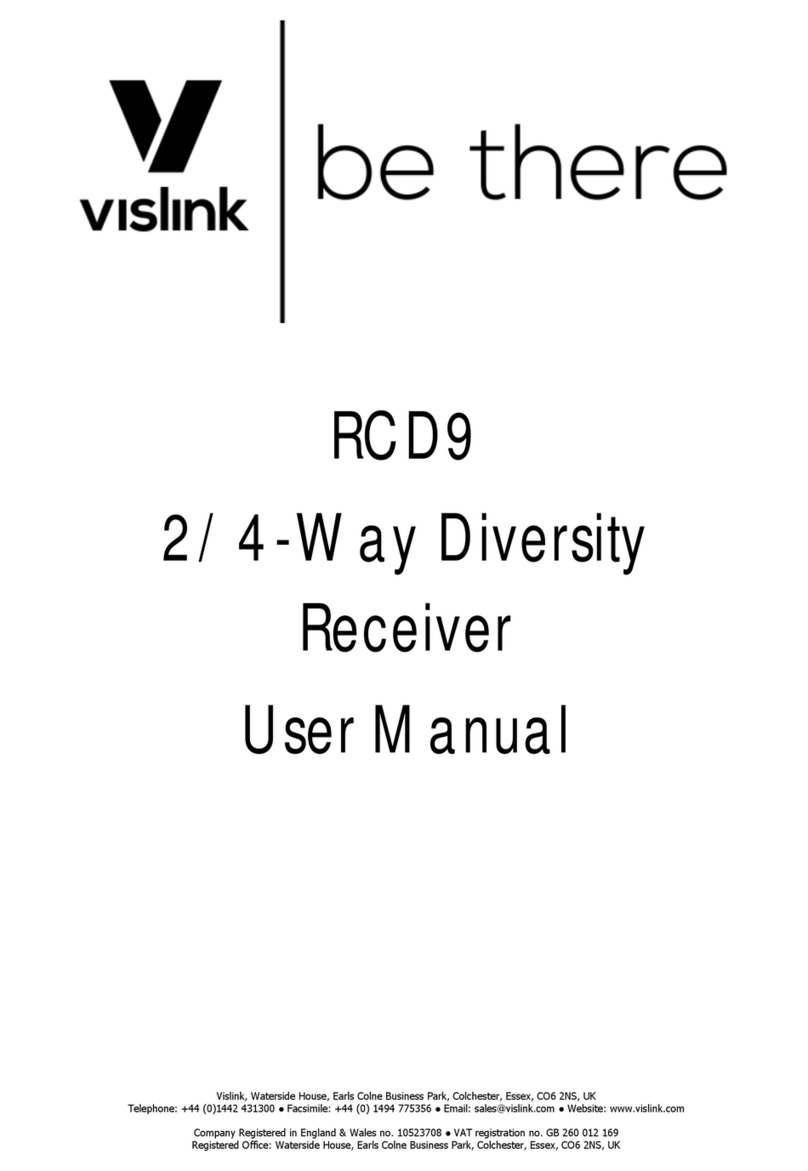
Vislink
Vislink RCD9 User manual

Vislink
Vislink HDR-5000 User manual
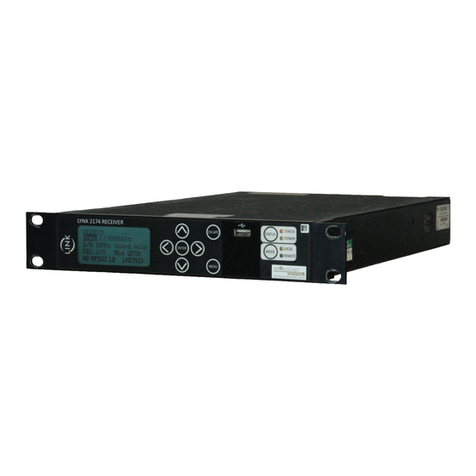
Vislink
Vislink Lynx L2174 User manual
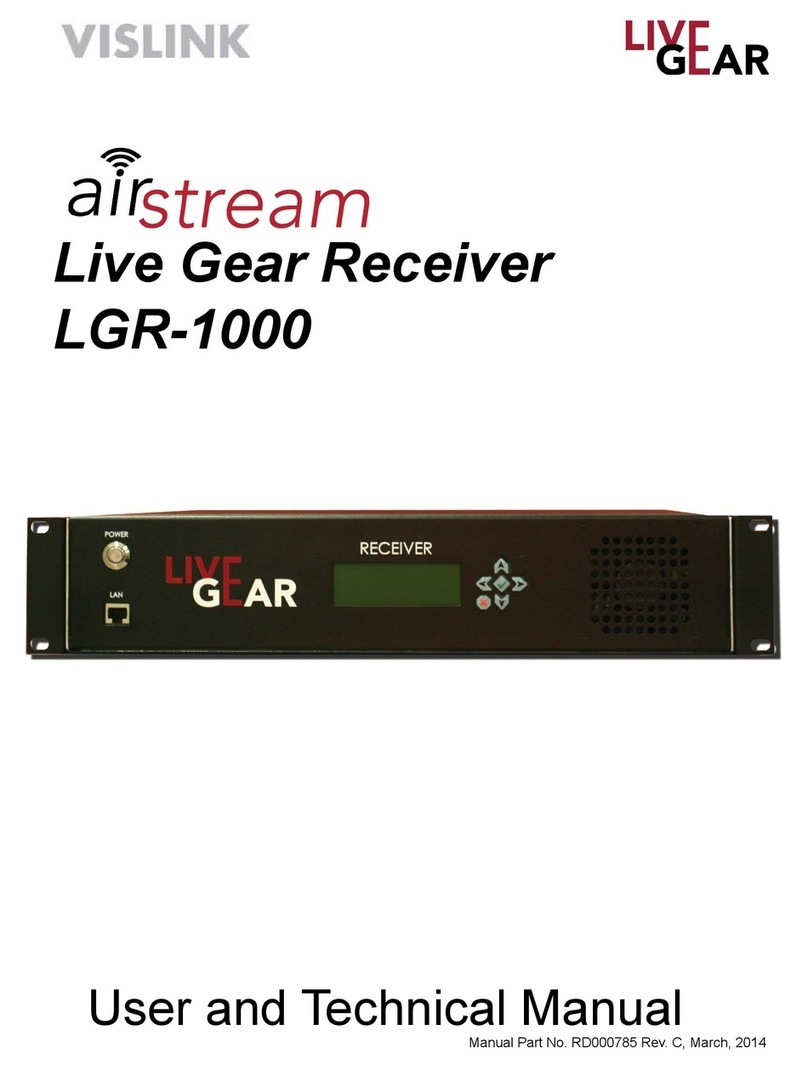
Vislink
Vislink airstream LGR-1000 User manual
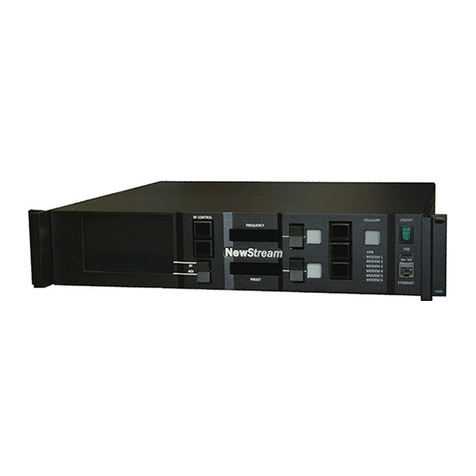
Vislink
Vislink Live Gear NewStream User manual

Vislink
Vislink Lynx L2174 User manual
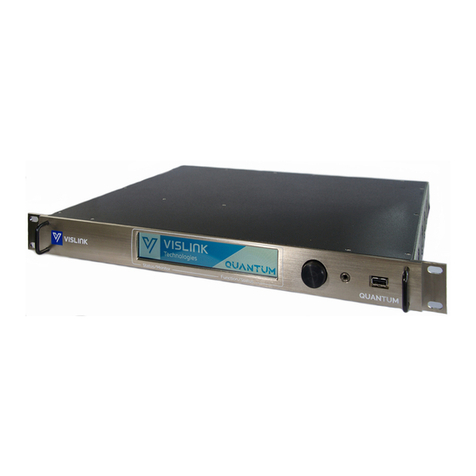
Vislink
Vislink Quantum User manual
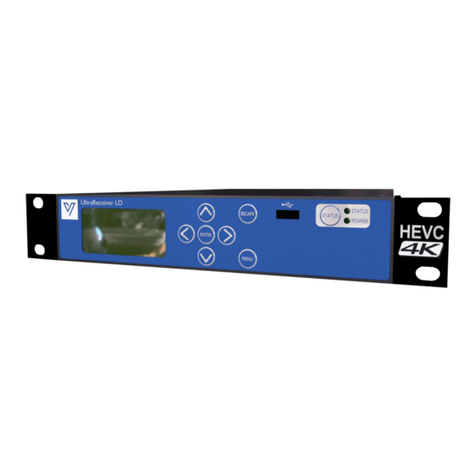
Vislink
Vislink UltraReceiver LD User manual
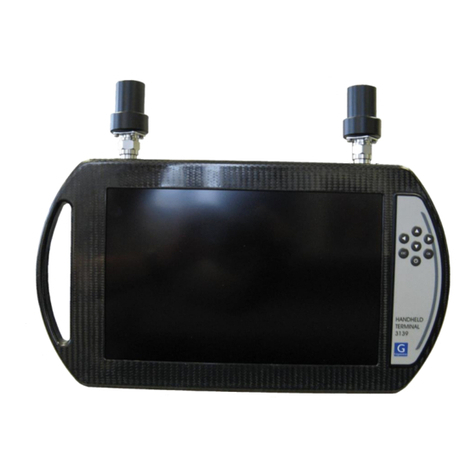
Vislink
Vislink HHT3 User manual
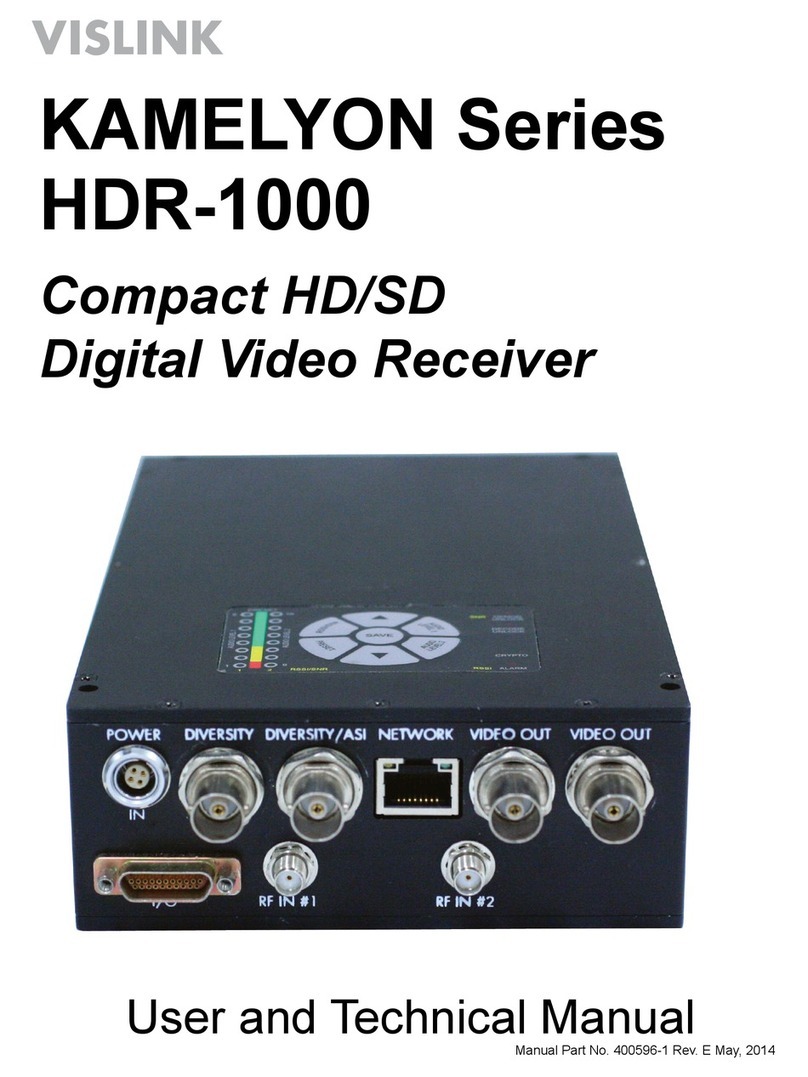
Vislink
Vislink HDR-1000 User manual
